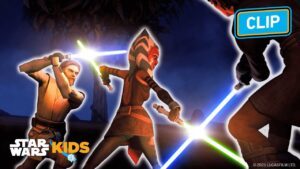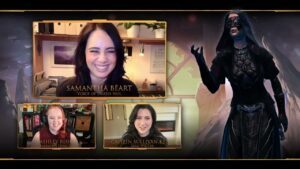Granblue Fantasy Versus may have introduced an entirely new fanbase to Gran’s grand adventure in 2020, but as a fan of the mobile RPGs before it, I came into Granblue Fantasy: Relink with very different expectations. Finally making the jump from phones to PC and PlayStation, the series has embraced exhilarating real-time action that feels right at home alongside other ambitious story-driven games like Final Fantasy XVI or Star Ocean: The Divine Force. But its clear mobile roots are a double-edged sword – the storytelling may be tighter and less bloated than its contemporaries, but other parts just don’t feel quite up to snuff for a game of this scale. Still, Granblue Fantasy: Relink’s fun combat and charming characters have kept me entertained for more than 35 hours already, even well after the credits have rolled.
Granblue Fantasy: Relink’s story follows a skyfaring crew on their search for a mysterious island called Estalucia that can make wishes come true. You play as a mostly silent protagonist (your choice between Gran and Djeeta) along with a young girl named Lyria, whose incredible summoning powers play a key part later in the story. The central cast has a nice mix of personalities – Io’s anxious demeanor balances out Rackam’s more steadfast confidence, and that well-rounded party creates plenty of interesting interactions between them.
After recently playing a pair of incredibly long RPGs in Persona 3 Reload and Like a Dragon: Infinite Wealth, I was expecting Relink’s main adventure to take at least 30 hours – however, its story is structured much more like a mobile game, which largely works in its favor. Each of its 10 chapters are concise and don’t drag their feet with more unnecessary dialogue than they have to. You have your objective for the chapter, go to a new location to complete it, defeat a boss, and then move on to the next one. It’s a refreshing change of pace to play an RPG that doesn’t want to waste your time and just gets straight into the action. As a result, I always felt like I was making some sort of meaningful story progress, and the main campaign can be completed in a satisfying 15-20 hours.
Relink isn’t short on cinematic moments, either. Right from the beginning, your crew is ambushed by monsters and you’re forced to fight them off as they try to board you. Some of the more amazing moments are even on par with Final Fantasy XVI’s biggest confrontations. For example, one chapter has you controlling Bahamut similar to those thrilling Eikon battles, while another has you climbing on a stone giant like you’re playing Shadow of the Colossus. Although Relink’s story doesn’t have the grandiose scope of something like Xenoblade Chronicles 3 or The Legend of Heroes: Trails into Reverie, it’s no less charming or emotional.
While the Granblue Fantasy series has many great characters, only a select few allies have actual roles in this story. That doesn’t stop others from showing up, however, as many more can be summoned using tickets you earn as rewards for finishing side activities. This allows the main cast’s personalities to shine even amongst a larger roster, and every character looks great both in and out of combat thanks to Relink’s eye-catching art style. The watercolor drawings and clean lines of their 2D portraits ooze charm in the main menu, and the 3D models are beautifully rendered, too, with faces that teem with emotion and life.
Every character has something called Fate Episodes, which are special scenes that provide lore and background on them, and even increase that person’s stats when you finish watching. This is where Relink’s mobile roots are at its weakest. Of the 10 or so Fate Episodes each character has, only maybe two or three have a playable component. The vast majority are just cutscenes that simply describe what’s going on in a comparatively boring way that made me wish more of them were fully fleshed out.
Even so, one of Relink’s greatest strengths is the mechanical diversity of its roster. Each character has a unique playstyle and special skills in a way that’s reminiscent of Genshin Impact. Those who prefer a straightforward swordfighter will be more than satisfied playing as Gran and Djeeta, hacking and slashing in a way that will surely be familiar for any fan of action RPGs like this. But if you’re feeling experimental, Eugen’s ranged attacks utilize a mix of bombs and even some light third-person lock-on and shooting mechanics. There are so many characters to try out that you’re bound to find a few favorites.
Relink’s real-time action combat also has a few features that help it stand out from similar games. The character you’re controlling has an Arts Level, which determines how effective your special skills are. The more normal attacks you dish out and longer you wait until you unleash a skill, the more powerful the skill will be. That creates an interesting risk and reward dynamic that’s constantly at play. For example, if your character has a healing skill, waiting until you reach Arts Level four will heal more HP than if you activate it at Arts Level one. But what if your HP is critically low and you need immediate help? Making those decisions is as important as it is fun.
My favorite combat feature, however, are Skybound Arts, which are powerful ultimate attacks unique to each character. Much like special attacks, Relink’s combat system also encourages you to wait before firing off Skybound Arts. You’re welcome to unleash yours right when your meter hits 100%, but if your entire party does so one after another, they’ll activate what’s called Full Burst, which is a group attack that deals enormous damage to your opponents, similar to something like Persona’s All-Out Attacks. Fortunately, you can also command your party to hold on to their own Skybound Arts before you activate your own, so you never have to worry about them going off prematurely.
Developer Cygames was originally working with PlatinumGames on Relink, and while that partner left the project in 2019, the studio’s fingerprints can still be felt throughout. Running around the different maps felt like I was playing as 2B and 9S in Nier: Automata again, with smooth and responsive controls as I went. Granblue Fantasy: Relink occasionally switches up its real-time action in a similar way, too, which prevents the combat from feeling stale. For example, when your ship gets raided, you can use the guns on the side of it to pick off enemies like a first-person-shooter before they have the chance to land. In another part, you’ll control a mech to fight against other robots, sort of like you’re playing an Armored Core game. While these moments may be short lived, they are still exciting and incredibly fun.
During the story and into the post-game, you’ll undertake tasks simply called Quests. These are sort of Monster Hunter-like missions where you gather your team to complete objectives, such as defeating a boss, eliminating waves of enemies, or protecting objects. Thankfully, you can tackle all of these in single-player mode with your NPC companions. However, this is also where Relink’s multiplayer shines the most. There are a plethora of matchmaking options that let you tailor your online sessions, whether you want to join up with a random group of strangers or search for specific people. You can also invite your own friends to join your lobby once you go online, so the process for getting a crew together is relatively smooth.
Unfortunately, the biggest issue with Relink’s multiplayer is that while PlayStation 4 and PlayStation 5 players can play with each other, there’s no crossplay between PlayStation and PC. This really limits the matchmaking potential and divides the user base of a game that already runs the risk of being fairly niche. The good news is that I didn’t see any connection or framerate issues when I played with a few of my buddies on PlayStation, so the online experience seems solid.
Completing Quests rewards you with materials needed to forge and upgrade weapons, as well as improve Sigils. Sigils are equippable orbs attached to your weapon that add a variety of different effects, such as decreasing skill cooldowns when hitting foes or increasing your base attack stat. There’s a lot of cool effects to play around with and tailor your specific playstyle toward. Some of the hardest post-game bosses and Quests aren’t for the faint of heart, so you’ll need proper Sigil planning in order to beat them. They offer ample challenges for you and your friends to take on after finishing the story, and the preparation makes the victory that much sweeter as you finally overcome those monsters.
Given Granblue Fantasy’s mobile roots, Relink does also have some light gacha mechanics, but thankfully no microtransactions. You can trade in unwanted Sigils or treasure for vouchers, which can then be redeemed to transmute new Sigils, which are seemingly random in which effect they give you. That’s a little obnoxious, but this system is relatively inoffensive as far as gacha mechanics go. Cygames also confirmed that it has no plans to implement any microtransaction trades in the future, so there’s no way to use real money to get a leg up in-game. This keeps the playing field equal amongst players and encourages you to spend more time playing instead of paying.
























